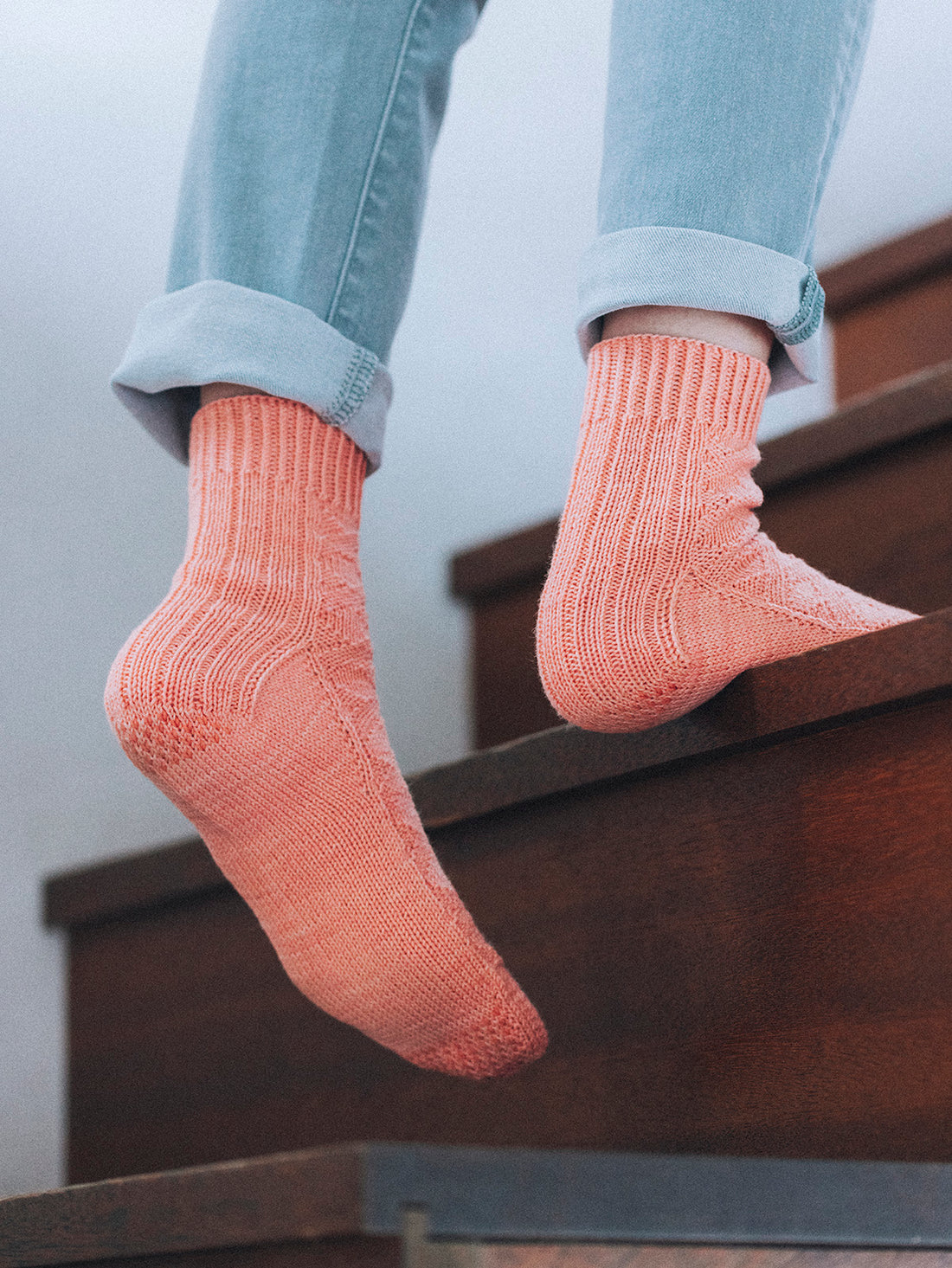
Koto by Yucca
Share
In the hot summer months it can be hard to get excited about working on a big project like a sweater, but socks are small and portable so they are great for knitting anywhere and everywhere! In Issue 24 we featured two sock designs and today we're checking in with Yucca, the designer of the Kyoto-inspired socks, Koto. If you've every visited the old capital of Japan, you might recognize Yucca's homage to the stone-paved streets seen in historic areas like Gion.
amirisu: What challenges did you encounter during the design process?
Yucca: I wouldn’t call it challenge, but I was surprised to find that the gauge for the hand-dyed Trek I used was slightly different from the main colorways. (It is a very small difference, and depending on the person you might not find any difference at all.)
Yucca: I wouldn’t call it challenge, but I was surprised to find that the gauge for the hand-dyed Trek I used was slightly different from the main colorways. (It is a very small difference, and depending on the person you might not find any difference at all.)
amirisu: If you were to knit this design in another color, what would it be?
Yucca: If I were to choose from the main Trek colors, I would pick Lichen.
amirisu: How did you start your knitting journey?
Yucca: First my mother taught me, then later I had the opportunity to learn in school, too.
Yucca: First my mother taught me, then later I had the opportunity to learn in school, too.
amirisu: Tell us a little bit about a favorite place of yours in the town or area you grew up in or where you live now.
Yucca: The Kamogawa River. It is a river that runs through Kyoto City for 23 kilometers. There is an area known as the Kamogawa Delta, named for its triangular shape, where two tributaries flow on either side of the land before joining together to create the Kamogawa River. There are often herons, ducks, kites, and sometimes even wild deer, and it is a popular place for people of all ages to relax and enjoy nature in the middle of the city.
amirisu: What is one handicraft or traditional art or skill from your country or region that you like or have an interest in?
Yucca: Kogin embroidery. I think I first encountered Kogin through the pieces done by my grandmother and aunt, they are from the Tohoku region where Kogin originated. Kogin began as a method of reinforcing and insulating fabric, so in that way it has something in common with darning. A couple of years ago I made a sock pattern that incorporated Kogin called Woolly Kogin. Kogin isn’t traditionally done with wool yarn or on a knitted fabric, but I liked the idea of introducing knitters to it by combining it with knitting. I hope that it sparks an interest in finding out more about the history of Kogin embroidery, too.
Thank you, Yucca!
--
セーターなど大きなプロジェクトを編むのが大変な暑い夏でも、いつでもどこでも編めてしまう靴下。amirisu24号には靴下パターンが2つ載っています。そのうちの一つが、日本の古都、京都が好きな人にとってはたまらないKoto。デザイナーのYuccaさんにお話を伺っていきます。
amirisu: デザインの過程で、どんな苦労や工夫がありましたか?
Yucca: 苦労というほどではありませんが、茜染めのTrekが、レギュラーのカラーのTrekとはゲージがすこし違ったところが、こんなこともあるんだなと勉強になりました。(そこまで差が大きいわけではないので、全く同じゲージで編める方もいらっしゃると思います)
amirisu: もう一枚編むとしたら何色で編みますか?
Yucca: Trekから選ぶならLichen
amirisu: 編み物を始めたきっかけは何でしたか?
Yucca: はじめは母に教わり、その後、授業で習う機会があったこと。
amirisu: あなたの住む町や生まれ育った町の好きな場所はどこですか?簡単に紹介してください。
Yucca: 鴨川。京都市内を23kmに渡って流れる川です。鴨川デルタと呼ばれる三角州があり、サギ、鴨、トンビなどのいろんな鳥や、たまに鹿がいたり、老若男女いろんな人がのびのび自由に過ごしています。
amirisu: あなたの国や地域に伝わる手工芸や技術について、好きなものを一つ選んで教えてください。
Yucca: こぎん刺し。はじめてこぎんに触れたのは、東北の祖母や叔母が刺した作品だったと思います。こぎんの役割には靴下のダーニングとも通じるものがあります。こぎん刺しの図案を取り入れた「Woolly Kogin」という靴下のパターンを作ったことがあります。編地に毛糸で刺しても、本当のこぎんとは別物ですが、靴下編みがこぎん刺しを知るきっかけになったら面白いな、という気持ちで作りました。こぎんの歴史にも興味を持ってもらえたら嬉しいです。
Yuccaさん、ありがとうございました。
